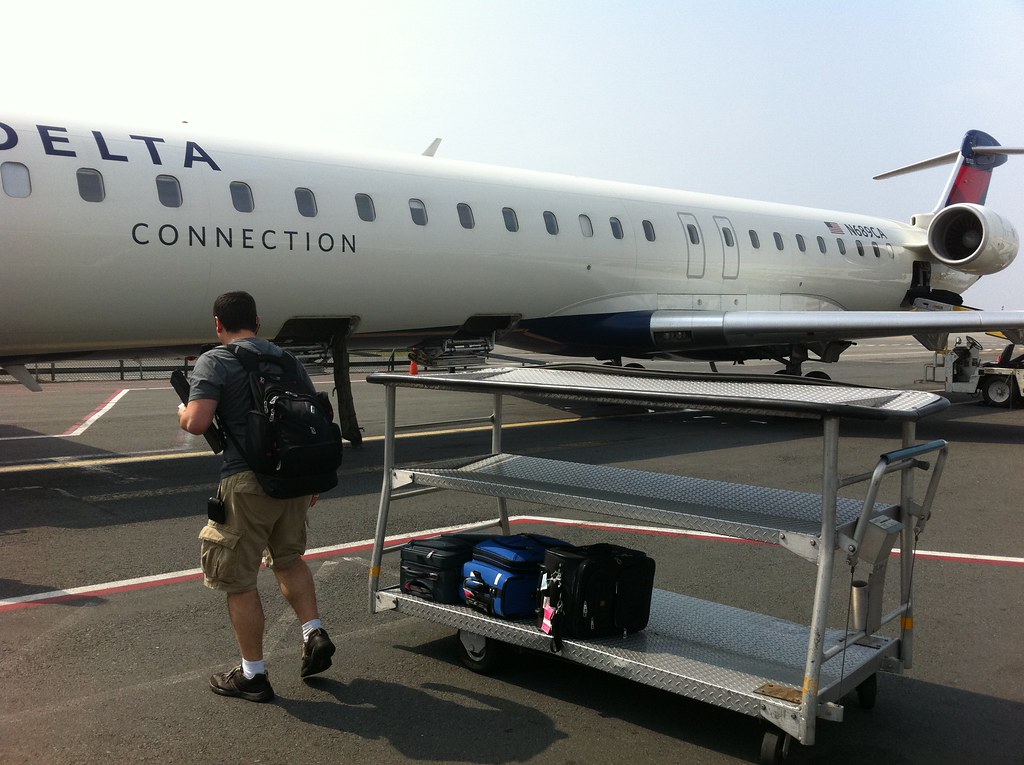Have you ever faced the dreaded airport moment, standing in front of a scale, hoping your suitcase doesn’t tip it over the weight limit? Or perhaps you’ve been hit with a hefty fee at check-in, one that could have bought you a nice dinner at your destination. If this sounds all too familiar, then you’re in for a treat, because there’s a travel hack that’s not only cost-efficient but also upgrades your flying experience significantly. This hidden gem? Checking the price to upgrade to first class instead of paying for checked baggage, especially on short flights.
The Complexity of Airline Baggage Fees
Let’s dive into a personal anecdote that might just change how you approach your next flight booking. Imagine planning a trip from Seattle to Helena, MT. You know you’ll have two suitcases in tow, pushing you into the realm of checked baggage fees, a realm where costs can quickly spiral to around $100. However, upon a closer look, the option to upgrade to first class presents itself, not at a sky-high price, but merely $30 more. This upgrade doesn’t just afford you two checked bags at no extra cost but also seats you in a realm of comfort far surpassing the cramped quarters of economy. In this particular journey, not only was comfort significantly enhanced, but there was also a savings of about $70. A win-win situation by any measure.
The variability of baggage fees across airlines is nothing short of bewildering. With the cost of checking your first, second, or even third bag differing drastically from one carrier to another, it’s crucial to be well-informed before you book your ticket. The baggage fee landscape is a mosaic of numbers that can be hard to navigate. For instance, if you’re flying with Alaska Airlines, your first bag could cost you $35, but book before a certain date, and you might save $5. American Airlines plays in the same ballpark for the first bag but push to the second, and you’re looking at $45, potentially less if you’re booking ahead of time. And then there’s Spirit, where the fees are as variable as the weather, requiring a direct consultation to pin down the exact cost.
It’s not just about the fees themselves; it’s about the entire experience. Upgrading to first class isn’t merely about avoiding those fees; it’s about embracing a level of service that can transform your travel experience. Beyond the legroom, first-class passengers often enjoy priority boarding, superior inflight meals, and a level of attentiveness from the airline staff that can make any journey feel more special.
Moreover, this approach to smartly manage baggage fees doesn’t just apply to solo travelers. Families or groups can especially benefit, where checking multiple bags can quickly add up to a small fortune. The trick lies in assessing the total cost of your travel including baggage fees and comparing it with the upgrade options available. In many cases, the math works out in favor of first-class, offering not just savings but an enriched travel experience.
It’s important to note, though, that this strategy requires some homework. Not all airlines are created equal, and neither are their first-class benefits or upgrade costs. It’s crucial to dive into the specifics of each airline’s baggage policy and first-class perks before making a decision. Fortunately, most airlines are transparent about these fees and benefits, providing detailed guides and fare calculators on their websites. Doing this legwork can unveil opportunities for savings and comfort that might otherwise have been overlooked.
Concluding this section, the anecdote shared at the beginning isn’t just a one-off lucky find. It represents a broader strategy that savvy travelers can employ to enhance their travel experience while keeping an eye on the budget. The realization that upgrading to first class could be more economical than paying for checked baggage, coupled with the added comforts of first-class travel, makes this approach a compelling consideration for your future travels. Whether it’s the avoidance of surprise fees, the allure of a comfier seat, or the overall improvement in travel quality, this strategy is worth exploring. In the end, it’s about making informed choices that elevate our travel experiences without unnecessarily inflating our expenses.
Navigating the complex world of airline baggage fees can feel like trying to solve a puzzle with pieces that keep changing shapes. Yet, understanding this landscape is crucial to making informed travel decisions that won’t break the bank. Let’s delve into the intricacies of baggage fees across various airlines, providing you with a comparative insight that could significantly impact how you approach booking your next flight.

Navigating Baggage Fees Strategically
The cost of checking a bag varies widely among airlines, turning what seems like a straightforward decision into a strategic game. For instance, while Alaska Airlines charges $35 for the first bag if booked after a certain date, that fee drops to $30 if you’re an early bird. This varying structure is a common theme across the board, with American Airlines and others offering similar incentives for early booking, showcasing the first lesson in baggage fee navigation: the early bird gets the worm, or in this case, the savings.
When comparing the cost of checking additional bags, the numbers continue to escalate, painting a picture of how quickly fees can add up. For those looking to check a second bag, the fees increase, with Alaska Airlines charging $45, but again, booking early can bring that down to $40. This trend of increasing prices for additional bags is consistent across airlines, with the third bag often jumping to a whopping $150, a steep incline that can catch any traveler off guard.
What stands out is the unique position of airlines like Southwest, which breaks the mold by not charging for the first or second checked bag. This anomaly in the airline fee landscape serves as a beacon for budget-conscious travelers, highlighting the importance of shopping around and comparing airlines based on total travel cost, not just the ticket price.
It’s not just about the fees themselves but also the limitations and conditions attached to them. For airlines like Spirit and Frontier, the calculus of baggage fees becomes even more complex due to their variable pricing models. These airlines require travelers to use their fare calculators to pinpoint the exact cost for their specific flight, emphasizing the need for detailed planning and early luggage fee payment to snag the lowest prices.

On the other side of the spectrum, airlines impose restrictions on the weight and size of checked luggage, adding another layer to the decision-making process. Notably, Spirit and Frontier set their standard checked bag weight limit at 40 pounds, below the industry average of 50 pounds, which can result in hefty fees for overweight bags. This highlights a critical baggage fee navigation tip: know your limits, both in weight and dimensions, to avoid unexpected charges.
Carry-on bags, though often free with most airlines, come with their own set of rules and potential fees, particularly with low-cost carriers. This brings us to the importance of understanding not just the cost of checking bags but also the policies around carry-on luggage. For instance, while airlines like Alaska, American, and Delta include a personal item and a carry-on item, budget airlines like Frontier and Spirit charge for carry-on items based on variable costs. This discrepancy underscores the importance of carefully reviewing what’s included in your fare before heading to the airport.
Navigating baggage fees isn’t just about dodging charges; it’s about leveraging available resources to minimize or eliminate these costs altogether. The role of cobranded airline credit cards and elite status in offering waived baggage fees can’t be overstated. For example, holding a United℠ Explorer Card or a Delta SkyMiles® Gold American Express Card can lead to substantial savings, not just for the cardholder but also for companions on the same reservation.
Understanding and navigating airline baggage fees is a multifaceted challenge that requires a strategic approach. By staying informed about the specific policies of each airline, booking early, knowing your luggage limits, and leveraging credit card benefits or elite status, you can turn what seems like a frustrating expense into a manageable, and sometimes avoidable, aspect of your travel budget. Remember, the goal isn’t just to get to your destination but to do so in a way that’s both enjoyable and economical, ensuring that your travel experiences remain enriching without unnecessarily draining your wallet.
Related posts:
Airline baggage fees: How much does it cost to check a bag?
When It Makes Sense To Upgrade to First Class
How to Get Upgraded to First Class in 2024





